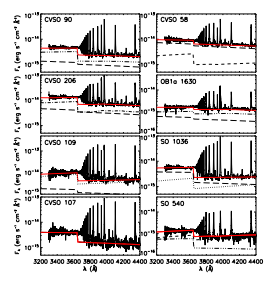 Previous observations of T Tauri stars have found that the accretion rate declines with age. Accretion rates have been observed as high as 10-4 solar masses per year for young T Tauri stars. Older T Tauri stars have been observed with accretion rates as low as 10-10 solar masses per year. There are a couple reasons why this happens. First, as material from the inner part of the disk accretes onto the star, the accretion disk is depleted in that region. If the disk does not evolve and move in to fill that region with more material, the accretion rate will drop. Alternatively, radiation from the newly-formed star could blow away the inner parts of the accretion disk, reducing the overall accretion rate. Once the accretion rate drops, astronomers refer to the systems as weak T Tauri stars. Classical T Tauri stars are those with higher accretion rates.
Previous observations of T Tauri stars have found that the accretion rate declines with age. Accretion rates have been observed as high as 10-4 solar masses per year for young T Tauri stars. Older T Tauri stars have been observed with accretion rates as low as 10-10 solar masses per year. There are a couple reasons why this happens. First, as material from the inner part of the disk accretes onto the star, the accretion disk is depleted in that region. If the disk does not evolve and move in to fill that region with more material, the accretion rate will drop. Alternatively, radiation from the newly-formed star could blow away the inner parts of the accretion disk, reducing the overall accretion rate. Once the accretion rate drops, astronomers refer to the systems as weak T Tauri stars. Classical T Tauri stars are those with higher accretion rates.
A few T Tauri stars have been found with high accretion rates up to 10 Myr, well after the accretion rate typically drops. Since not many of these systems have been observed, it is unclear whether they are anomalous or represent a different evolutionary path. In this paper, the authors look at eight T Tauri stars to measure their ages and mass accretion rates. They find seven systems which have accretion rates higher than would be expected.
Read the rest of this interesting story on Astrobites.

